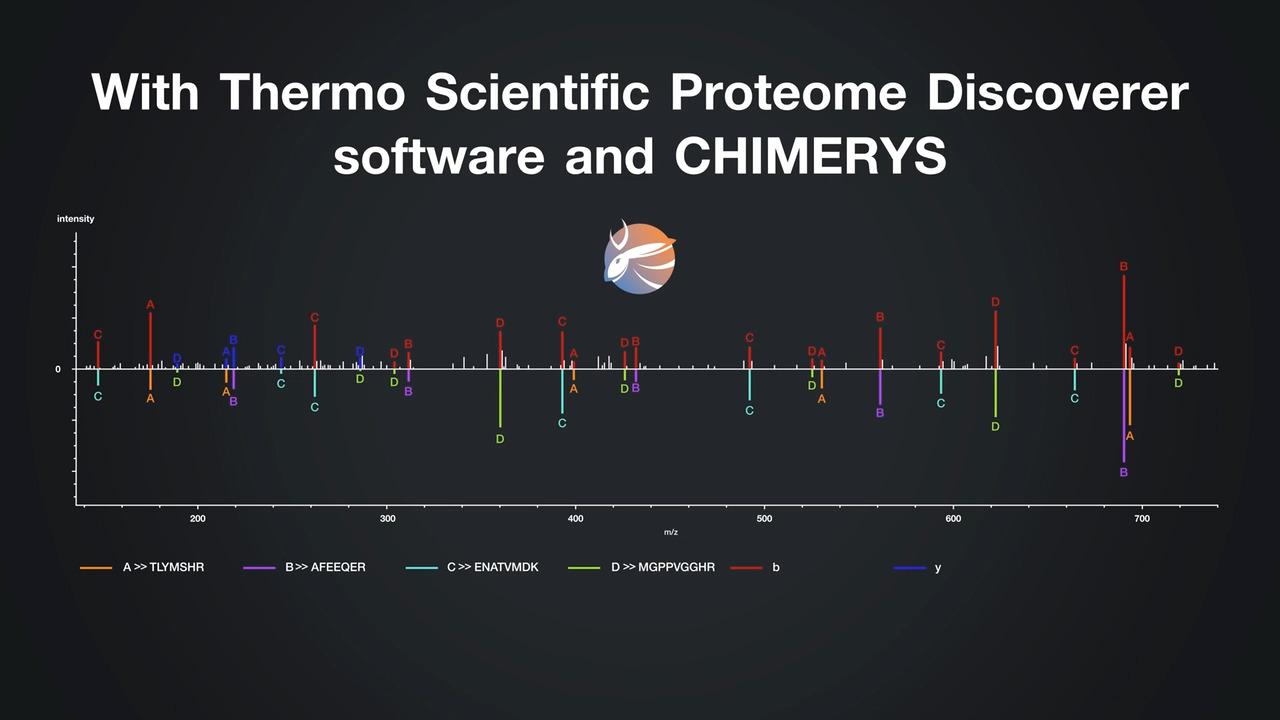Discover how to transform proteomics mass spectrometry data into insights
Comprehensive, extensible, and intelligent platform
Thermo Scientific Proteome Discoverer software is the ultimate toolbox for protein research scientists, enabling a full suite of customizable data analysis workflows for complex acquisition methods. Manage your datasets for statistical analyses, biological annotation, and data interpretation and simplify the identification and quantification of proteins in complex biological samples for a wide range of proteomics workflows. The software streamlines all major proteomics needs including peptide and protein identification, PTM analysis, isobaric mass tagging, and label-free quantitation (LFQ) from data-independent (DIA), data-dependent (DDA), and wide window (WWA) acquisitions. Achieve your goals with analysis of glycopeptides, top-down proteomics, proteoform analysis, and MS-based structural biology of chemical cross-linking XL-MS, all under the same unifying, versatile and community-enhanced protein informatics system. Proteome Discoverer software delivers comprehensive data analyses through supporting multiple database search algorithms and dissociation techniques within the same workflow.
Go beyond searching to discovering, with intelligent INFERYS™ Rescoring and the novel CHIMERYS™ intelligent search algorithm by MSAID. These innovative approaches substantially increase the identification rate, protein coverage, PTMs, and the number of unique peptide identifications enabling scientists to generate more biological insights from their existing and newly acquired data. CHIMERYS 2.0 also improves protein quantitation capabilities for isobaric mass tags as well as LFQ with DIA, DDA, and WWA acquisitions.
Hidden traces – Using chimeric spectra to boost protein identification rates
Identifying & quantifying MHC antigens with immunopeptidomics.
Key benefits
| Customize your data analysis | Perform relative quantitation | Extensible workflow tools |
|---|---|---|
Use the node-based workflow editor to customize your data analysis for maximum coverage and confidence. Integrate database search results from multiple search engines such as SEQUEST™ HT, Mascot, MSAmanda, Byonic™ from Protein Metrics, and Thermo Scientific ProSightPD software. Increase confidence in peptide identification and quantification using INFERYS Rescoring and enable a deeper mining of your DIA, DDA, or WWA data using the CHIMERYS 2.0 intelligent search algorithm. | Measure and report the relative expression levels of isotopically labeled peptides for:
Confidently and efficiently interpret your data with integrated statistical and visualization tools for a faster time to meaningful results. | Utilize third-party nodes and build in customization with the scripting node, while maintaining full integration into the Proteome Discoverer software framework to leverage visualization, statistical analysis, and biological interpretation tools to take your analysis to the next level. |
Comprehensive tools for proteomic studies
With a wide range of database search options and the ability to combine the output from multiple algorithms, Proteome Discoverer software increases confidence in results and decision making through cross-validation. Augment searches with intelligent INFERYS Rescoring to increase confidence in peptide identification and quantitation. Whether you acquire your data in DIA, DDA, or WWA mode, CHIMERYS 2.0 intelligent search algorithm helps you dig deeper into your data to substantially increase the number of unique peptide identifications, improve protein coverage, extend quantitation capabilities, and uncover new insights.
Complete sequence coverage and confident identification of post-translational modifications (PTMs) is realized with support for multiple dissociation techniques including collision-induced dissociation (CID), higher-energy collision-induced dissociation (HCD) and electron-transfer dissociation (ETD) in tandem with built-for-purpose search engines.
Customizable data analysis workflows
Automate and simplify data analysis through customizable workflows including full support for multiple quantitative workflows. Enjoy experimental flexibility for quantitation by employing isobaric mass tagging with TMT and TMTpro reagent or other isotopic labeling strategies or utilize label-free quantitation techniques. Map quantitative data to biological information through study management and leverage fast, robust algorithms for peak selection and peptide quantification to extract the maximum possible information from quantitative proteomics studies.
Refine acquisition strategies by generating inclusion and exclusion lists that can be directly imported into instrument methods. Confidently and easily facilitate data comparison, exchange, and verification in compliance with data standards developed by the HUPO Proteomics Standards Initiative (PSI).
Workflow tools
Proteome Discoverer software is designed for agility and extensibility, with a vast array of community-contributed nodes and scripts to enable additional workflow capabilities such as glycoproteomics, top-down proteomics, PTM analysis and cross-linking.
Featured resources
Rethink What Is Possible with Orbitrap Astral Mass Spectrometer
Manage, Automate, Process, and Share proteomics data
Explore a New Dimension in Proteomics Quantitation
Real-Time Search enables a new standard for TMT
Use SMOAC to enhance phosphoproteome coverage
Crosslinking mass spec (XL-MS) goes mainstream
Improvements to ProSightPD nodes
Single shot proteomics data acquisition
Applications
- High Throughput TMT Quantitation: Perform concurrent analyses to increase throughput and enable relative quantitation of up to 18 different samples
- Targeted Proteomics with SureQuant: A complete assay from sample preparation to quantitation of target peptides, with easy set up and high confidence in results
- Single-Cell Proteomics: Move away from bulk sample to single-cell proteomics analysis, which reveals the full complexity of cellular diversity
- Protein Phosphorylation: Gain understanding of the role of protein phosphorylation in biological processes and human health and disease
- Top-down Proteomics: Top-down approaches can detect degradation products, sequence variants, and determine PTMs
- Glycopeptide Analysis: Due to its many biological functions, glycosylation is one of the most-studied PTMs of eukaryotic cell proteins
- Viral Proteomics: Study how viruses interact with host cells, immune system responses, and viral system life-cycle functions
- Cross linking: Understand how proteins affect biological processes such as signaling cascades, gene upregulation, and energy production
- Flexible Quantitative Workflows: Gain quantitative insights into the dynamic processes that drive the biology of cells, tissues, and organisms
Order























